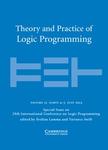版权所有:内蒙古大学图书馆 技术提供:维普资讯• 智图
内蒙古自治区呼和浩特市赛罕区大学西街235号 邮编: 010021

作者机构:Vienna Univ Technol TU Wien Inst Log & Computat Vienna Austria
出 版 物:《THEORY AND PRACTICE OF LOGIC PROGRAMMING》 (逻辑程序设计理论与实践)
年 卷 期:2022年第22卷第5期
页 面:739-754页
核心收录:
学科分类:08[工学] 0835[工学-软件工程] 0701[理学-数学] 0812[工学-计算机科学与技术(可授工学、理学学位)]
基 金:Bosch Center for Artificial Intelligence at Renningen Germany
主 题:answer-set programming visual question answering neuro-symbolic computation
摘 要:We present a neuro-symbolic visual question answering (VQA) pipeline for CLEVR, which is a well-known dataset that consists of pictures showing scenes with objects and questions related to them. Our pipeline covers (i) training neural networks for object classification and bounding-box prediction of the CLEVR scenes, (ii) statistical analysis on the distribution of prediction values of the neural networks to determine a threshold for high-confidence predictions, and (iii) a translation of CLEVR questions and network predictions that pass confidence thresholds into logic programmes so that we can compute the answers using an answer-set programming solver. By exploiting choice rules, we consider deterministic and non-deterministic scene encodings. Our experiments show that the non-deterministic scene encoding achieves good results even if the neural networks are trained rather poorly in comparison with the deterministic approach. This is important for building robust VQA systems if network predictions are less-than perfect. Furthermore, we show that restricting non-determinism to reasonable choices allows for more efficient implementations in comparison with related neuro-symbolic approaches without losing much accuracy.